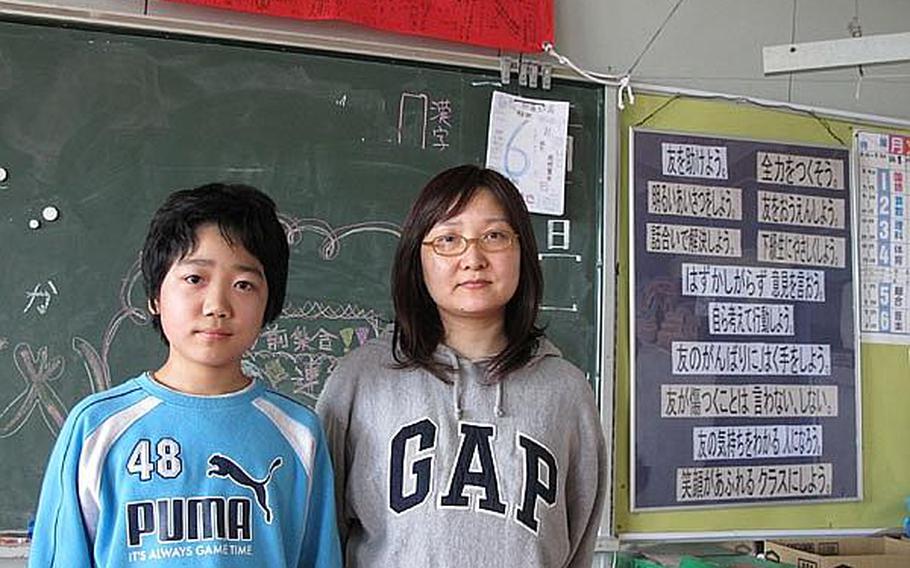
Iori Nametaka, 12, and his mother, Kyoko, live in a classroom with other families at Okaido Elementary School in Ishinomaki, a city ravaged by the March 11 tsunami in northeast Japan. The Nametakas have applied for temporary housing, but there is a long wait. Meanwhile, the school's educators are trying to teach hundreds of students while making room for the 202 evacuees living on school grounds. (Erik Slavin/Stars and Stripes)
ISHINOMAKI, Japan — Until 11:45 a.m., Ami Iimori, 8, goes to school on the first floor of Okaido Elementary School.
Afterward, she walks to the second floor classroom that she has called home for the last six weeks. She jumps around on the blankets laid out on the floor with her brother, Yoshi, 4, and sweeps up her little sister Miu, 1, in her arms. The children from the other families living in the classroom join in the horseplay sometimes.
“I’m happy here. It’s fun,” Ami says.
Her parents, Misuhiro and Kazuko Iimori, appear relieved at their children’s resilience. But they also worry about any trauma the March 11 earthquake and tsunami might have caused them.
“The kids haven’t seen the house yet,” Kazuko said. “There’s a truck on top of the roof. It looks like something tossed in a washing machine.”
The Iimoris are among thousands of people that lost their homes when the tsunami hit Ishinomaki, a seaside city of about 160,000 people in Japan’s northeast. Nearly 5,000 people from the city are either dead or remain missing. Two of the dead are 9-year-olds from Okaido Elementary. Their parents picked them up from school after the earthquake, only to be swept up in the tsunami 30 minutes later.
Educators at the school now find themselves in a difficult role: not only must they teach, they must help children recover from the trauma they’ve experienced, even as the teachers themselves pick up the pieces of their own lives.
Because this is the beginning of the new school year in Japan, teachers are just beginning to form relationships with their students, said Okaido vice principal Osamu Kitamura.
“As they go on, teachers will probably talk to them about the disaster,” Kitamura said. “Right now, we’re just listening to what the kids have to say.
“The kids have lost so many things, we’ll have to figure out from their mannerisms and the way they speak what they’re feeling.”
The school is bringing in outside counselors to help staff members and children cope, Kitamura said. It’s an unusual step. Unlike most U.S. schools, the school doesn’t normally have counselors.
On Monday, the 355 students at the school will return to class full-time. The 202 evacuees living in classrooms will move to the school gymnasium over the weekend.
Several of the children who both live and go to school at Okaido were putting up a brave front this past week.
Iori Namekata, 12, thought he was leaving elementary school behind for good at the end of the school year. Instead, he rides his bicycle from the Okaido shelter over to his new middle school.
He tries to find small ways to lift his spirits.
“I have a lot of friends, so I spend time with them,” said Namekata, who lives in a room with his mother, Kyoko, and several other families.
The Namekatas recently applied for temporary housing, but they are among thousands who have applied for the 135 homes now ready in their area.
In the meantime, they believe living in the gymnasium will at least be an upgrade. Unlike in the classroom, they have heard they will have electricity during the day and partitions for privacy.
Eiji Kai, 10, isn’t happy to be living at school and, like a lot of children around the world, would also rather be doing just about anything other than studying.
When the tsunami hit, Eiji stayed in the multi-story Okaido school and watched through the windows as the water level rose.
“It was scary,” he said. “I saw cars being washed away.”
Eiji’s mother, Yoshiko, swam through the streets from another shelter to reach him the next day, she said.
Nevertheless, Eiji said he’s had a few bright moments in the past few weeks. Eiji exchanged email addresses with four U.S. soldiers, who had come with a group from Camp Zama and Okinawa to clean up the school.
One of the soldiers had real blond hair, which Eiji had never seen before.
“They were pretty cool,” Eiji said.
Every room in the school was cleansed five or six times of the muck that invaded on March 11 by U.S. soldiers, Japan Self-Defense Force troops, teachers and by volunteers who had probably never heard of Ishinomaki before arriving.
“We are grateful not only to the Japanese, but everybody in the world that has supported us,” Kitamura said. “We can show our thanks to the world by helping our children … by showing them that our children are going to be OK.”